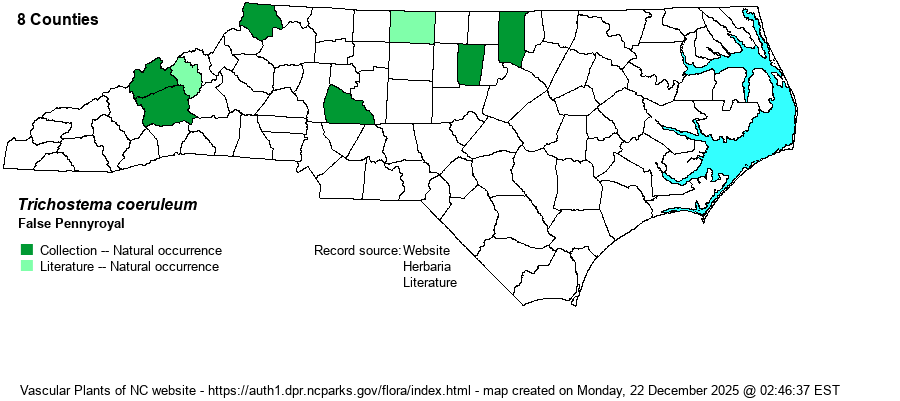| Author | (Michx.) K.S.McClell. & Weakley | |
| Distribution | Found only in a few places in the Mountains and northern Piedmont. Specimens documented for Ashe, Buncombe, Granville, Madison, Orange (historical), and Rowan counties. There is a current and certainly valid sight record for Rockingham County, and a long-historical one from Yancey County. Thus, currently present sparingly in the northern Piedmont and south to the central Mountains. Note that the species was not known from the state when RAB (1968) was published; the authors must have dismissed the very old report from Yancey County.
This is a wide-ranging species essentially to the north and west of NC. It ranges from New England to northern SC, to AL, and to TX.
| |
| Abundance | Very rare in the northern Piedmont and central Mountains. Certainly could occur in a few more sites in these two provinces, but even though a small plant, it probably is not being overlooked. It is a State Endangered species with a State Rank of S1. | |
| Habitat | This species is restricted to quite high pH soil, only over mafic or calcareous rocks, such as diabase, limestone, or other calcareous material. It favors dry, often rocky sites, or at least where the soil is very thin and at times a bit gravelly. Communities in NC include Diabase Barrens, Dry Calcareous Cliffs, and Mafic Cliffs. |
| Phenology | Blooms in August and September, and fruits shortly after flowering. | |
| Identification | This is a quite small species that would easily be overlooked by the general public, though a careful botanist/biologist working in dry and high pH soil might not. It has several branches (usually), but even so grows only to about 9 inches tall, rarely 1-foot tall. It has numerous opposite leaves, each elliptical and about 1-inch long and half as wide, tapered at the base and tip. It is nearly sessile, is practically entire on the margins, and has 3 prominent veins. Many of the leaf axils, mostly in the upper portions, have one to several tiny blue flowers, each with 5 petals nearly symmetrical (and thus not looking like a mint), but only about 1/6-inch across. It looks nothing like the other three Trichostema species in the state, leaving one to wonder why it was moved into this distinctly different genus. The species will likely be quite difficult to identify when not in bloom, as the elliptical leaves and small stature of the plant do not catch attention; but, if the blue flower color is seen on a plant, then a close look is warranted. | |
| Taxonomic Comments | This species was formerly placed in the genus Isanthus, named as I. brachiatus. When moved to the genus Trichostema, it was then named as T. brachiatum. Only since 2023 or 2024 has it been moved to T. coeruleum.
| |
| Other Common Name(s) | Glade Bluecurls, Pennyroyal Bluecurls, Fluxweed | |
| State Rank | S1 | |
| Global Rank | G5 | |
| State Status | E | |
| US Status | | |
| USACE-agcp | | |
| USACE-emp | | |

